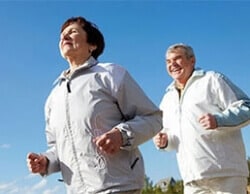
It’s something we’ve all heard for years: Exercise can help keep older adults healthy. But now a study, the first of its kind to look at frail, older adults, proves that physical activity can help these people maintain their mobility and dodge physical disability.
A new University of Florida study shows daily moderate physical activity may mean the difference between seniors being able to keep up everyday activities or becoming housebound. In fact, moderate physical activity helped aging adults maintain their ability to walk at a rate 18 percent higher than older adults who did not exercise.
“The very purpose of the study is to provide definitive evidence that physical activity can truly improve the independence of older adults,” said principal investigator Marco Pahor, director of UF’s Institute on Aging.
What’s more, moderate physical activity not only helped older adults maintain mobility but also helped prevent the occurrence of long-term mobility loss. Co-principal investigator Jack Guralnik, a professor of epidemiology and public health at the University of Maryland School of Medicine, said there was a 28 percent reduction in people permanently losing the ability to walk easily.
“The fact that we had an even bigger impact on persistent disability is very good,” said Guralnik, who also holds a faculty position at UF. “It implies that a greater percentage of the adults who had physical activity intervention recovered when they did develop mobility disability.”
Researchers showed that prescribed daily physical activity can prevent older adults’ loss of mobility, defined in the study as the ability to walk 400 meters, or about a quarter of a mile. Although 400 meters might sound like an arbitrary number, it’s an important figure for older adults, researchers said.
“Four hundred meters is once around the track, or from the parking lot to the store, or two or three blocks around your neighborhood,” Guralnik said. “It’s an important distance in maintaining an independent life.”
Called the Lifestyle Interventions and Independence for Elders, or LIFE, study, the study took place across eight field centers. There were two Florida field center recruitment sites at the University of Florida and Jacksonville Brooks Rehabilitation as well as field centers at Northwestern University, Pennington Biomedical Research Center, the University of Pittsburgh, Stanford University, Tufts University, Wake Forest School of Medicine and Yale University.
The researchers recruited 1,635 sedentary men and women ages 70 to 89 for the study. The participants could walk a quarter mile within 15 minutes but were at risk of losing that ability. Low physical performance can be a predictor of early death and higher hospitalization and institutionalization rates, and patients with low physical performance are not often recruited to large studies, Pahor said.
“These are people who are patients we see every day. This is why this study is so important: It includes a population that is typically understudied,” Pahor said.
The participants were randomly separated into two groups and followed for an average of 2.6 years. The first group of 818 walked 150 minutes per week and did strength, flexibility and balance training. They were monitored by two visits to field centers per week. The second group of 817 were asked to take part in a less physically demanding regimen, only attending health education classes and performing stretching exercises. This phase of the study occurred between February 2010 and December 2013.
Staff members assessed study participants every six months, checking their ability to walk, their body weight, blood pressure and pulse rate, among other measurements. The staff was not told which participants were assigned to physical activity or to the education classes.
“It’s quite a vulnerable and high-risk population,” Pahor said. “Both age and poor health were factors. We selected people who had low physical performance, which is a strong predictor for future morbidity, hospitalization, institutionalization and mortality.”
Wendy Kohrt, professor of medicine in the division of geriatric medicine at the University of Colorado, helped review the scientific merit of the study before the launch of the main LIFE trial. She said the information produced by this study fills gaps in researchers’ knowledge of the types of people enrolled in the study.
“As an exercise scientist, I believe this type of research is absolutely critical to establish scientific evidence on which to make recommendations for how lifestyle can beneficially influence health status,” Kohrt said. “There is a general belief among the public and the scientific and medical communities that we know exercise is good for you, so why do we need to do more research in this area? However, we still do not know whether certain types or doses of exercise are better than others, particularly for specific health conditions or diseases. The LIFE trial demonstrated that a modest increase in physical activity has the potential to help older adults maintain functional independence.”
Source: University of Florida
This article is provided for informational purposes only and should not be construed as specific medical advice. Do not begin an exercise regimen without consulting your physician.